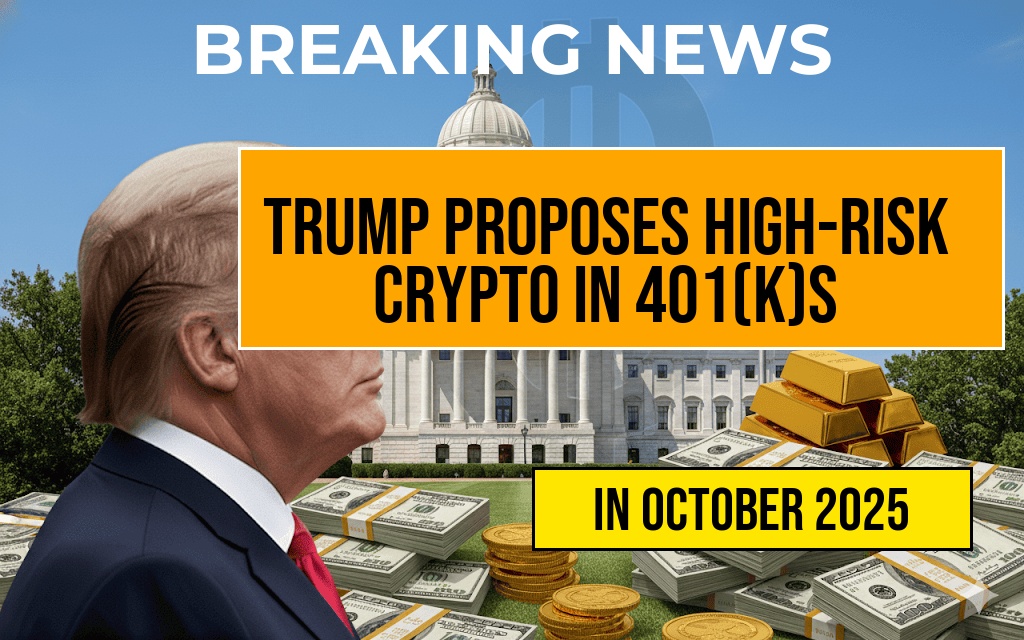Former President Donald Trump has announced a bold proposal advocating for a new regulatory framework that would permit high-risk cryptocurrency investments within 401(k) retirement plans. This initiative is aimed at allowing American workers greater flexibility in their retirement savings options, potentially enabling them to capitalize on the rapid growth of the digital currency market. Trump’s plan comes amidst a growing trend among investors looking to diversify their portfolios through alternative assets, including cryptocurrencies. The proposal has elicited mixed reactions from financial experts, regulatory bodies, and the general public, who are weighing the benefits of potential higher returns against the risks associated with volatile markets.
Details of the Proposed Regulation
The envisioned regulations would create a new category of investment options within 401(k) plans, specifically targeting cryptocurrencies and other high-risk assets. Trump contends that this move could empower workers to take control of their financial futures and harness the potential for significant returns, especially as digital currencies continue to gain traction among mainstream investors.
Key Features of the Proposal
- Expanded Investment Options: The new rule would allow plan sponsors to offer cryptocurrencies as part of their investment lineup, providing employees with more choices for retirement savings.
- Risk Disclosure Requirements: To ensure that investors are fully informed, the proposal includes provisions for clear disclosures about the risks associated with investing in cryptocurrencies.
- Investment Education: Trump’s plan emphasizes the importance of education, suggesting that employees receive training on the complexities and volatility of crypto investments.
Support and Opposition
The proposal has garnered support from segments of the financial community that advocate for innovation and increased investment freedom. Proponents argue that allowing cryptocurrencies in retirement accounts could lead to higher returns for investors, particularly for younger workers who have a longer time horizon to recover from potential losses.
However, the plan faces significant scrutiny from financial regulators and consumer protection advocates. Critics express concerns about the inherent risks associated with cryptocurrency investments, which have been known for their price volatility. Forbes reports that many financial experts believe that including such high-risk assets in retirement portfolios could jeopardize the financial security of workers.
Regulatory Landscape
The U.S. Securities and Exchange Commission (SEC) has been increasingly vigilant regarding the cryptocurrency market, emphasizing the need for regulatory oversight. With Trump’s proposal, the SEC’s response will be critical in determining whether such investments can be safely integrated into traditional retirement plans. The potential for regulatory pushback could shape the final form of any new rules.
Market Reactions and Future Implications
The announcement has sparked discussions across social media and financial platforms, with many weighing in on the potential impact of such a policy change. Supporters view it as a necessary evolution in retirement planning, while detractors emphasize the risks involved. Market analysts have noted that the cryptocurrency market’s volatility raises fundamental questions about its suitability for retirement savings, suggesting that the proposal could lead to a broader debate about investment strategy.
| Pros | Cons |
|---|---|
| Potential for high returns | High volatility and risk of loss |
| Diversification of retirement portfolios | Regulatory uncertainty |
| Increased investment options for employees | Need for investor education and awareness |
Conclusion
As the discussion surrounding Trump’s proposed rule unfolds, stakeholders from various sectors will likely continue to evaluate the implications of integrating cryptocurrencies into retirement plans. The balance between innovation and investor protection will be a central theme in this ongoing debate, particularly as the demand for alternative investment strategies grows in an evolving financial landscape. Whether this proposal will gain traction remains to be seen, but it certainly adds another layer to the conversation about the future of retirement savings in America.
For further insights into the evolving landscape of cryptocurrency regulation, consider exploring resources from Investopedia and the SEC’s Cybersecurity Division.
Frequently Asked Questions
What is the proposed new rule regarding 401(k) plans and cryptocurrency investments?
The proposed new rule would allow individuals to invest a portion of their 401(k)high-risk cryptocurrencies, potentially increasing their chances for higher returns.
Who is advocating for this change in 401(k) investment options?
The change is being advocated by former President Donald Trump, who believes that allowing crypto investments will benefit retirement savers.
What are the potential risks associated with investing in cryptocurrencies through 401(k) plans?
Investing in cryptocurrencies is considered high-risk due to their volatility and lack of regulation, which could lead to significant losses for retirement savers.
How might this new rule affect the average retirement saver?
If implemented, the new rule could give the average retirement saver access to alternative investment options, potentially allowing for greater diversification but also increasing their exposure to market volatility.
Are there any current regulations that limit cryptocurrency investments in retirement plans?
Yes, currently, most 401(k) plans do not allow investments in cryptocurrencies due to regulatory concerns and the associated risks, making this proposed rule a significant change.

Leave a Reply